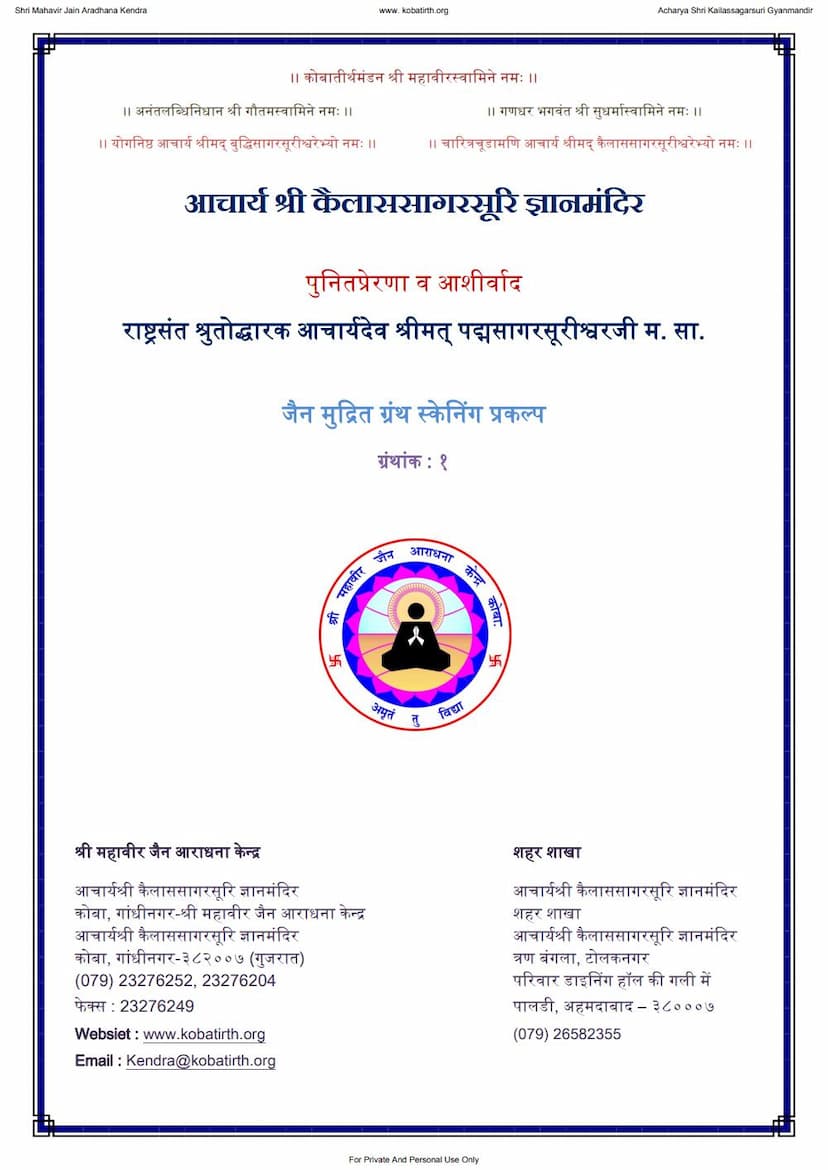Agam 41 Mool 02 Ogh Pind Niryukti Sutra Shwetambar
Added to library: September 1, 2025

Summary
The provided text is a digital scan of the Jain text "Agam 41 Mool 02 Ogh Pind Niryukti Sutra" according to the Shwetambar tradition, with commentary by Purnachandrasagar, published by Jainanand Pustakalay. The scan is made available by the Shri Mahavir Jain Aradhana Kendra, Acharya Shri Kailassagarsuri Gyanmandir.
The initial pages (1-2) are introductory, offering salutations to various Jain deities, acharyas, and gurus, and stating the purpose of the text for private and personal use. It also lists the website and email addresses of the institution.
Page 3 and onwards show a dedication to Acharya Shri Anandsagarsurishwarji Maharaj, highlighting his role in revising and editing the 45 Agamas. It also credits the inspiration and guidance for the work, including disciple Ganivarya Shri Purnachandrasagarji Maharaj, and institutions like Jainanand Pustakalay.
The subsequent pages delve into the history and importance of the Agamas, discussing their composition by the Gandharas (disciples of Lord Mahavir) and the subsequent five major recitations (Vachanas) or compilations of the Agamas. These recitations were crucial for preserving the Jain scriptures through various challenging periods, including famines and political upheavals.
The text details the purpose of each recitation:
- First Recitation (Pratham Vachana): Conducted at Pataliputra (Patna) under the leadership of Shri Sthulabhadra Swami, focusing on the compilation of the Dwadashangi (Twelve Angas) after a severe famine.
- Second Recitation (Dwitiya Vachana): Held in Ujjain under Acharya Shri Aryasuhasti Suri, aimed at preserving the Agamas during the reign of Samprati.
- Third Recitation (Tritiya Vachana): Involved 200 Jinakalpi ascetics, 300 Sthavirakalpi ascetics, 300 nuns, and thousands of lay followers, to systematically organize the eleven Angas and ten Purvas.
- Fourth Recitation (Chaturth Vachana): Took place in Dashpur (Mandsaur) around Viranirvana Samvat 592, initiated by Acharya Shri Aryarakshit Suri, who organized the four Anuyogas to ensure the longevity of the Agamas.
- Fifth Recitation (Pancham Vachana): Held around Viranirvana Samvat 830-840 in Mathura and Valabhi, with Acharya Shri Skandil Suri and Acharya Shri Nagarjun Suri leading the efforts to consolidate the Agamas.
- Sixth Recitation (Shashthi Vachana): Conducted in Valabhi (Vallabhipur) by Acharya Shri Devdhdhigani Kshamasramana and Acharya Shri Kalak Suri, with the assistance of divine beings, to permanently codify the 84 Agamas onto palm leaves.
The text also laments the decline in the transmission of Agamic knowledge due to the influence of adverse times starting from the 10th century, making the Agamas rare even for qualified individuals. It highlights the revival efforts in the late 20th century, particularly by the "Sagar Shaka" and the significant contributions of Acharya Shri AnandSagar Surishwarji Maharaj in re-printing and propagating the Agamas.
The core of the text (starting from page 12) is the Ogh-Pind Niryukti Sutra itself, written in Prakrit, which seems to be a detailed commentary or explanation related to the Pind (collection, accumulation) and its various aspects within the Jain monastic code. The sutra discusses principles related to:
- Right Conduct (Charitra): Emphasizing self-control, devotion, knowledge, penance, and control of anger as essential components of right conduct.
- Purity of the Body and Mind: Discussing the importance of purifying the body, adhering to strict rules (Samitis), contemplation, control of senses, and self-discipline.
- Specific Rules and Guidelines: Detailing procedures for carrying out daily activities, including purification of utensils (pratilekhan), managing food and resources (pind vishuddhi), proper conduct during meals, and various rules for ascetics and nuns.
- Ethical Conduct: Touching upon ethical considerations in interactions, the importance of avoiding harm to living beings (both gross and subtle), and the consequences of actions.
- The Path to Liberation: Ultimately guiding the practitioner towards liberation through adherence to these principles and practices.
The text is highly detailed, outlining numerous rules and principles for monastic life, indicating a deep level of philosophical and practical instruction within Jainism. The script is in an ancient Indian language, likely Prakrit or Ardhamagadhi, with extensive commentary. The overall tone is instructional and devotional, emphasizing the rigorous path to spiritual purification and liberation.